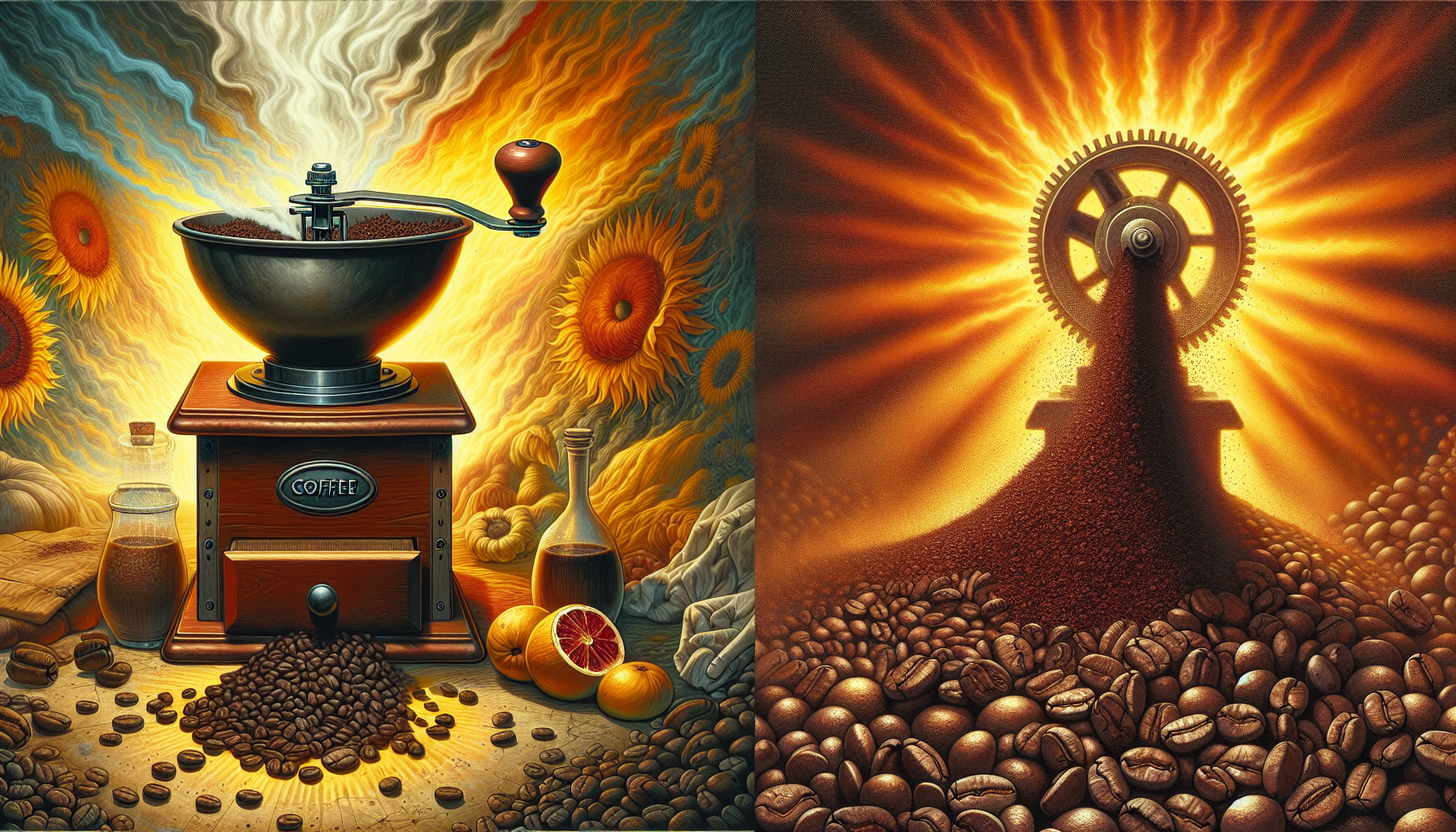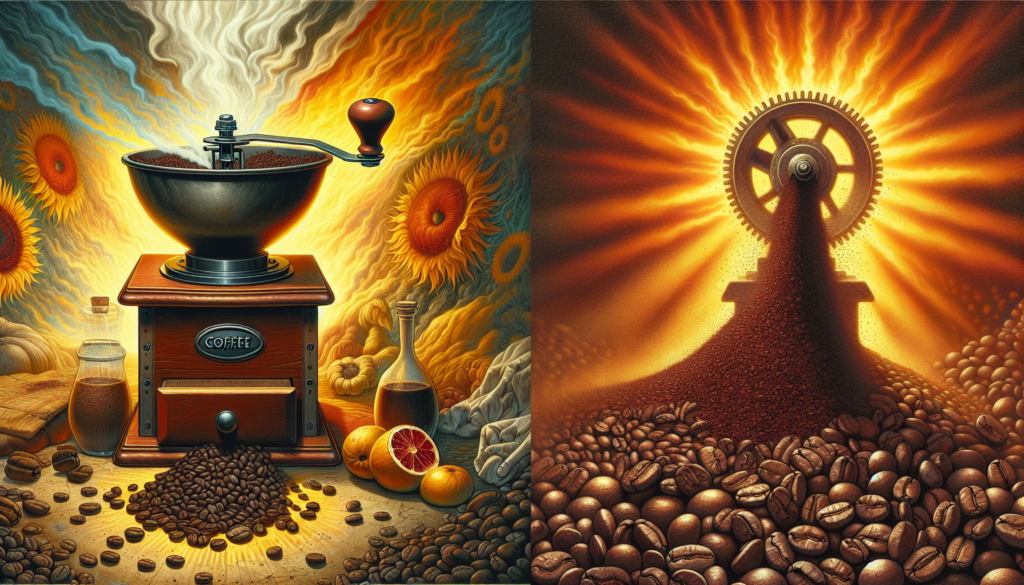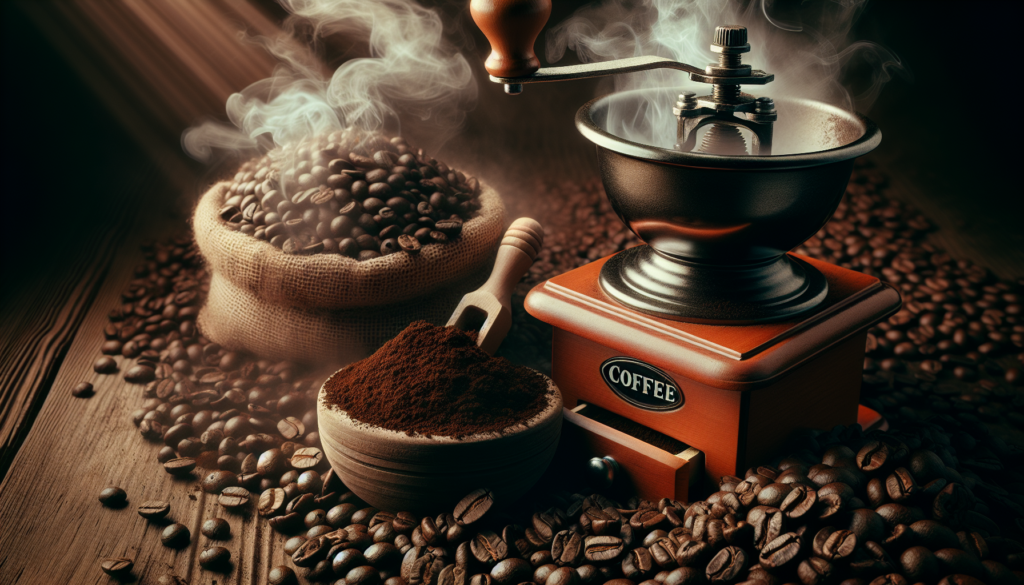
You may not realize it, but the process of grinding coffee beans and the temperature at which it occurs can greatly affect the flavor and quality of your cup of coffee. In this article, we will explore the fascinating relationship between heat and coffee grinding, delving into how different temperatures can impact the taste, aroma, and even the storage life of your beloved beans. Whether you’re a coffee connoisseur or just an avid drinker, understanding these factors will enable you to elevate your coffee experience to a whole new level of enjoyment. So grab a cup of your favorite brew, sit back, and prepare to discover the hidden secrets behind the perfect grind.

Roasting Coffee Beans
Roasting Process
Roasting coffee beans is a crucial step in bringing out the rich and aromatic flavors that we all love in our daily cup of joe. It is during the roasting process that the green coffee beans are transformed into the brown beans we are familiar with. The process involves subjecting the beans to high heat, leading to various chemical reactions that ultimately determine the flavor profile of the final product.
Impact of Heat on Coffee Beans
Heat is the key factor that plays a significant role in the roasting process and its impact on coffee beans. When coffee beans are exposed to heat, they undergo a series of complex reactions that result in the development of flavors and aroma. The heat causes the beans to expand, and as a result, the moisture content within them evaporates. This leads to the caramelization of sugars and the breakdown of other organic compounds, resulting in the characteristic flavors we associate with coffee.
Bean Color and Flavor Development
The color of coffee beans also plays a vital role in understanding the flavor development during the roasting process. As the beans heat up, they transition from green to yellow, then to light and medium brown, and finally to dark brown. This color change signifies the development of flavors and the intensity of the coffee. Lighter roasts tend to retain more of the original characteristics of the coffee bean, while darker roasts develop bolder and more robust flavors.
Grinding Coffee Beans
Importance of Grinding
Grinding coffee beans is a critical step in the coffee brewing process. When you grind beans, you expose a larger surface area of the coffee to the brewing water, enhancing extraction and allowing for a more flavorful cup of coffee. The quality of the grind is crucial as it determines the rate of extraction and the overall taste of the brewed coffee.
Impact of Heat during Grinding
Heat generated during grinding can have a significant impact on the flavor of the coffee. Excessive heat can cause the coffee beans to lose some of their delicate aromas and flavors, resulting in a less desirable cup of coffee. Therefore, it is essential to have measures in place to manage the heat generated during the grinding process.
Grind Size and Extraction
the size of the coffee grind is another factor that affects the extraction process. Finer grinds expose more surface area to the water, allowing for quicker extraction. Coarser grinds, on the other hand, result in a slower extraction process. It is crucial to find the right grind size for your brewing method to ensure optimal flavor extraction.
Heat and Coffee Flavor
Chemical Reactions during Roasting
Heat triggers a series of chemical reactions during the roasting process, which give coffee its unique flavors and aromas. One key reaction is the Maillard reaction, the process where sugars and amino acids combine, forming new flavor compounds. This reaction happens between 300-400°F and is responsible for producing the caramel, nutty, and toasty flavors commonly found in roasted coffee.
Volatility of Coffee Aromas
Heat has a significant impact on the volatility of coffee aromas. As the temperature rises, aroma compounds become more volatile and easily evaporate. This is why freshly brewed coffee has a strong and enticing aroma. Properly managing heat during brewing is crucial to preserve and enhance the aroma of coffee.

Effect of Heat on Coffee Quality
Bitterness and Acidity
Heat also affects the balance of flavors in coffee. When coffee is subject to high temperatures for too long, it can result in a bitter taste. On the other hand, under-extraction due to inadequate heat can lead to an overly acidic cup. Achieving the right balance of bitterness and acidity is key to a well-rounded and enjoyable coffee experience.
Balance of Flavors
Heat is crucial in achieving a balanced and harmonious blend of flavors in coffee. The controlled application of heat during roasting and brewing allows for the development and preservation of the desired flavors. The degree of roasting and the temperature of brewing greatly influence the balance of flavors, ensuring a satisfying cup of coffee.
Heat and Coffee Brewing
Temperature for Brewing
The temperature at which coffee is brewed plays a vital role in determining the extraction and flavor of the final cup. Ideally, water temperature should range between 195-205°F (90-96°C) for optimal extraction. Too low of a temperature may result in under-extraction, leading to weak and watery coffee, while temperatures above the recommended range can lead to over-extraction, causing bitterness.
Impact of Heat on Extraction
Heat is directly linked to the extraction process during brewing. The rate of extraction is influenced by the water temperature, grind size, and contact time. Higher temperatures increase extraction speed, whereas lower temperatures can slow it down. By carefully managing the heat, you can control the extraction and achieve a well-balanced and flavorful cup of coffee.
Choosing the Right Grinder
Burr Grinders vs. Blade Grinders
When it comes to choosing the right grinder for your coffee beans, there are two main options: burr grinders and blade grinders. Burr grinders are generally considered superior because they offer a more consistent and precise grind size, resulting in a more even extraction. Blade grinders, on the other hand, tend to produce a less uniform grind, which can lead to uneven extraction and an inconsistent flavor profile.
Heat Generation in Grinders
Both burr grinders and blade grinders generate heat during the grinding process. However, it is important to note that burr grinders generate less heat due to their design, which reduces the risk of heat affecting the flavor of the coffee. Blade grinders, on the other hand, can generate heat through friction, potentially altering the taste of the final brew.
Managing Heat during Grinding
Preventing Heat Build-up
To prevent heat build-up during grinding, it is recommended to grind the coffee in short bursts rather than continuously. This allows the grinder to cool down between grinding sessions, reducing the risk of excessive heat affecting the coffee’s flavor. By taking breaks and grinding in smaller batches, you can maintain the quality and consistency of your coffee.
Cooling Methods
If you are using a grinder that tends to generate more heat, such as a blade grinder, there are methods to help cool down the beans during the grinding process. One method is to place the grinder in the freezer for a few minutes before grinding. This can help lower the temperature of the beans, reducing the impact of heat on their flavors. Another option is to grind the beans in a well-ventilated area to allow for better airflow and prevent excessive heat build-up.
Storage and Heat Exposure
Impact of Heat on Coffee Storage
Heat can have a detrimental effect on the freshness and quality of stored coffee. Exposure to high temperatures can accelerate the oxidation process, causing the coffee to stale more quickly. It is crucial to store coffee in a cool and dry place to minimize the impact of heat on its flavor and aroma.
Avoiding Heat Exposure
To ensure the longevity and quality of your coffee, it is essential to avoid unnecessary heat exposure. Keep your coffee stored in airtight containers away from direct sunlight, as both heat and light can degrade the coffee’s quality. Additionally, avoid storing your coffee near appliances that generate heat, such as ovens or stovetops.
Conclusion
Balancing Heat and Coffee Quality
Understanding the impact of heat and managing it throughout the coffee bean roasting and brewing processes is crucial to achieving a high-quality cup of coffee. Heat plays a significant role in flavor development, extraction, and overall coffee experience. By paying attention to heat levels and implementing appropriate techniques, you can ensure a well-balanced and flavorful brew.
Maintaining Flavor through Heat Management
From the roasting process to grinding and brewing, heat management is essential for preserving the delicate flavors and aromas of coffee. By understanding the impact of heat and employing proper techniques, such as controlling temperature, grind size, and exposure to heat, you can enhance the overall flavor profile of your coffee and enjoy a consistently satisfying cup every time.
References
- Coffee Research Foundation. (2021). Heat And Coffee Grinding: Understanding The Impact On Coffee Beans. Retrieved from [link to be added].